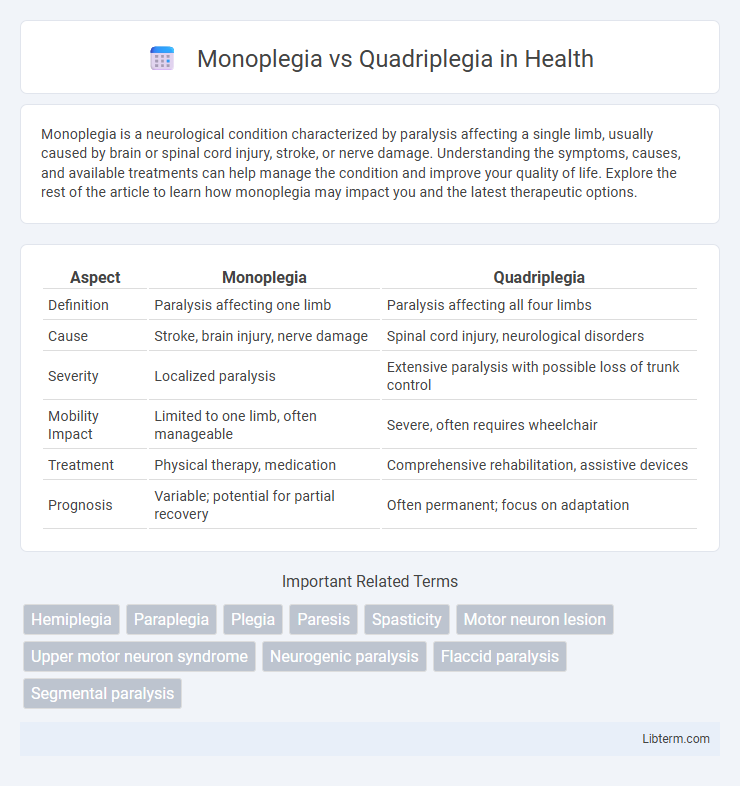Monoplegia is a neurological condition characterized by paralysis affecting a single limb, usually caused by brain or spinal cord injury, stroke, or nerve damage. Understanding the symptoms, causes, and available treatments can help manage the condition and improve your quality of life. Explore the rest of the article to learn how monoplegia may impact you and the latest therapeutic options.
Table of Comparison
| Aspect | Monoplegia | Quadriplegia |
|---|---|---|
| Definition | Paralysis affecting one limb | Paralysis affecting all four limbs |
| Cause | Stroke, brain injury, nerve damage | Spinal cord injury, neurological disorders |
| Severity | Localized paralysis | Extensive paralysis with possible loss of trunk control |
| Mobility Impact | Limited to one limb, often manageable | Severe, often requires wheelchair |
| Treatment | Physical therapy, medication | Comprehensive rehabilitation, assistive devices |
| Prognosis | Variable; potential for partial recovery | Often permanent; focus on adaptation |
Understanding Monoplegia and Quadriplegia
Monoplegia refers to paralysis affecting a single limb, typically caused by localized brain or spinal cord injury, while quadriplegia involves paralysis of all four limbs due to damage in the cervical spinal cord region. Understanding the distinct neurological damage patterns helps tailor rehabilitation strategies and improve patient outcomes in both conditions. Early diagnosis using MRI and nerve conduction studies is crucial for determining the extent of paralysis and guiding treatment plans.
Causes of Monoplegia and Quadriplegia
Monoplegia primarily results from localized brain injuries, such as strokes or cerebral palsy, affecting a single limb, while quadriplegia is typically caused by spinal cord injuries at the cervical level, leading to paralysis of all four limbs. Traumatic events like car accidents or severe falls are common causes of quadriplegia, whereas monoplegia often arises from more focal neurological damage such as that seen in multiple sclerosis or localized trauma. Understanding these distinct etiologies aids in targeted treatment and rehabilitation strategies for each condition.
Key Differences Between Monoplegia and Quadriplegia
Monoplegia refers to paralysis affecting a single limb, typically caused by localized brain or spinal cord injury, whereas quadriplegia involves paralysis of all four limbs resulting from damage to the cervical spinal cord. The extent of motor function loss is restricted to one limb in monoplegia, while quadriplegia causes extensive motor and sensory deficits across both arms and legs. Recovery potential varies, with monoplegia often having a better prognosis due to limited nerve involvement compared to the widespread impairment seen in quadriplegia.
Common Symptoms and Manifestations
Monoplegia primarily affects one limb, causing paralysis, muscle weakness, and loss of motor control in the affected arm or leg. Quadriplegia involves paralysis of all four limbs, often accompanied by impaired respiratory function, loss of sensation, and autonomic dysfunction. Both conditions may present muscle spasticity, decreased reflexes, and challenges with coordination depending on the extent of nerve or spinal cord injury.
Diagnostic Procedures and Evaluation
Diagnostic procedures for monoplegia primarily involve neurological examinations, electromyography (EMG), and imaging techniques like MRI to assess localized nerve or brain damage affecting a single limb. In contrast, quadriplegia diagnosis requires comprehensive spinal cord imaging, including MRI and CT scans, along with neurological assessments to determine the extent of paralysis affecting all four limbs. Both conditions benefit from functional assessments and electrophysiological studies to evaluate motor and sensory impairments.
Treatment Options for Monoplegia
Treatment options for monoplegia typically involve physical therapy aimed at improving strength and mobility in the affected limb, often combined with occupational therapy to enhance daily function and independence. In some cases, medications such as muscle relaxants or anti-spasticity drugs may be prescribed to manage muscle stiffness and pain. Advanced interventions like nerve stimulation or surgical procedures might be considered for severe cases where conservative treatments have limited effectiveness.
Treatment Approaches for Quadriplegia
Treatment approaches for quadriplegia focus on comprehensive multidisciplinary rehabilitation including physical therapy, occupational therapy, and respiratory support to enhance mobility and independence. Advanced options such as functional electrical stimulation, assistive technologies, and surgical interventions aim to improve function and quality of life. Management also involves addressing complications like spasticity, pressure sores, and respiratory infections through medication and preventive care strategies.
Rehabilitation Strategies
Rehabilitation strategies for monoplegia primarily target restoring function and strength in the affected single limb through intensive physical therapy, occupational therapy, and task-specific training. Quadriplegia rehabilitation requires a comprehensive approach, addressing paralysis in all four limbs by incorporating advanced technologies like functional electrical stimulation, assistive devices, and neuroplasticity-driven therapies to improve mobility and independence. Both conditions benefit from personalized rehabilitation plans that emphasize neurorehabilitation, muscle strengthening, and adaptive techniques to maximize recovery outcomes.
Impact on Daily Life and Mobility
Monoplegia affects a single limb, often resulting in limited movement and strength in that specific area, which can complicate tasks requiring fine motor skills or balance but generally allows for greater overall mobility compared to quadriplegia. Quadriplegia involves paralysis of all four limbs and typically impairs not only motor function but also essential activities such as walking, dressing, and feeding, leading to a higher dependency on assistive devices and caregiver support. The severity of mobility restriction in quadriplegia significantly impacts daily life, often necessitating wheelchair use, whereas monoplegia may allow partial independence with adaptive tools.
Outlook and Long-Term Management
Monoplegia involves paralysis of a single limb, often allowing for greater mobility and independence compared to quadriplegia, which affects all four limbs and commonly results in more complex health challenges. Long-term management of monoplegia may emphasize physical therapy and localized support devices, whereas quadriplegia requires comprehensive multidisciplinary care including respiratory support, spasticity management, and assistive technologies. Prognosis varies with injury severity and rehabilitation intensity, but early intervention improves functional outcomes and quality of life in both conditions.
Monoplegia Infographic

 libterm.com
libterm.com